The Great, Geeky Quantum Debate
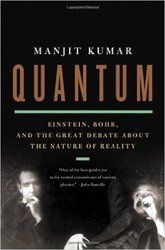 Because of my disabilities and for a small yearly fee, I am entitled to download free digital copies of books from the impressively large library of Bookshare.org. Unfortunately and contrary to what I was led to believe when I was offered the opportunity to join, its content is only readable using a proprietary, Windows-based program. Not on my Nook. Conversion programs (which violate my terms-of-use agreement) are available but do a poor job rendering these books into my preferred epub format.
Because of my disabilities and for a small yearly fee, I am entitled to download free digital copies of books from the impressively large library of Bookshare.org. Unfortunately and contrary to what I was led to believe when I was offered the opportunity to join, its content is only readable using a proprietary, Windows-based program. Not on my Nook. Conversion programs (which violate my terms-of-use agreement) are available but do a poor job rendering these books into my preferred epub format.
Someday it may be more convenient for me to use the Bookshare program. Most content for it is available as text or audio. In the meantime, I make some use of “found epub editions” scattered liberally about the darkest corners of the Internet. But it is much easier to find samizdat copies of fiction than nonfiction (celebrity biographies are an exception, and the shallower the celebrity the more likely their biographies can be found). This also seems to be true of legitimate electronic content available from public libraries.
It is a good thing I enjoy novels. Occasionally though, I do find a nonfiction gem. Manjit Kumar’s Quantum: Einstein, Bohr and the Great Debate about the Nature of Reality is one such gem I was thrilled to discover.[1]
This is a long post on a subject that may be of little interest to you. However, you will be rewarded at the end if you are persistent enough to get there. It would be unfair of you to scroll ahead just to find it!
—
I have long been a fan boy of science writing targeted to a general audience. Natural history, cosmology and theoretical physics are my particular areas of interest.[2] I am out of my depth in all three areas, of course, but theoretical physics is especially deep water for me. I can’t do the math. I do love, however, the thrill of those fleeting moments of near-clarity that offer glimpses into the depths.
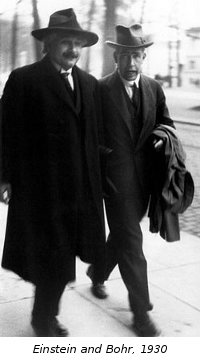 Richard Feynman is supposed to have said, “If you think you understand quantum mechanics, you don’t understand quantum mechanics.” (This appears to be a variation on something said earlier by Neils Bohr.[3]) This may no longer be true of an exclusive coterie of physicists, but it is most assuredly true for most of us. Certainly it is for me. But, wow, Kumar does a heckuva job of making it as approachable as possible for fan boys and girls such as me.
Richard Feynman is supposed to have said, “If you think you understand quantum mechanics, you don’t understand quantum mechanics.” (This appears to be a variation on something said earlier by Neils Bohr.[3]) This may no longer be true of an exclusive coterie of physicists, but it is most assuredly true for most of us. Certainly it is for me. But, wow, Kumar does a heckuva job of making it as approachable as possible for fan boys and girls such as me.
The book is full of remarkably clear expositions of this difficult material accompanied by helpful diagrams. Just enough to make the fascinating story of the discovery of the quantum world and its strangeness a riveting read. But it is the history of the men[4] involved and the glimpse into the uncertain, meandering struggle toward scientific truth that will stay with me[5].
—
I will not attempt to regurgitate what I think I have learned about quantum mechanics (and in doing so expose my various misunderstandings and half-understood conceptualizations of it). If you want a voyeur’s peek into the fascinating quest to understand the quantum world or an explanation of the “Copenhagen interpretation” and why it so disturbed Einstein, you must read the book. I can only offer a few of the random particles of thoughts about the scientists and their lives and work that are rattling around in my head at the moment.
¶ Late in his life Einstein wrote, “I thought a hundred times as much about the quantum problems as I have about general relativity theory.” Despite my familiarity with Einstein’s biography and work, I never fully appreciated the extent to which his attempts to come to terms with the implications of quantum mechanics haunted him.[6]
¶ Neils Bohr was a mensch. In addition to mentoring a host of physicists who made impressive contributions to our understanding of physics at its most mysterious, he himself had a huge role in the development of what would later be known as the “Copenhagen interpretation.”[7] He was a worthy foil for Einstein and the two men held each other in the highest esteem.
¶ Despite his working on the fringes of the quantum question, Einstein’s keen ability to construct “thought experiments” served to challenge Bohr and others to test, retest and test again every assumption and implication of their theories. Einstein’s “Lightbox” thought experiment is one example. The EPR paradox (“Spooky Action at a Distance”) is another and it still has never been fully and satisfyingly resolved. It is an impetus for the ongoing search for a theory of everything[8].
¶ Wolfgang Pauli made huge contributions that are outlined in this book. He was quite a character and I picture him as something of physics’ Oscar Wilde. Portly and with an acerbic tongue.
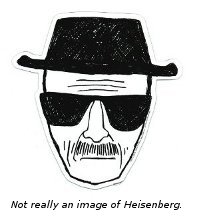 ¶ The rivalry between Heisenberg and Schrödinger makes for fascinating reading. Heisenberg as champion of the particle; Schrödinger of the wave. They were both right. More specifically, Heisenberg insisted that no intuitive conception of the quantum world was possible and that a purely mathematical description was the only way to think about it. Schrödinger felt just as strongly that the physical world—even at the smallest of scales—must be capable of description. Early on, at least, Bohr sided with Heisenberg, while Einstein agreed with Schrödinger.
¶ The rivalry between Heisenberg and Schrödinger makes for fascinating reading. Heisenberg as champion of the particle; Schrödinger of the wave. They were both right. More specifically, Heisenberg insisted that no intuitive conception of the quantum world was possible and that a purely mathematical description was the only way to think about it. Schrödinger felt just as strongly that the physical world—even at the smallest of scales—must be capable of description. Early on, at least, Bohr sided with Heisenberg, while Einstein agreed with Schrödinger.
¶ “Schrödinger’s cat” is one of the most famous thought experiments ever devised. In the book, Schrödinger is described as being a ladies man (another thing he and Einstein had in common). In fact, Kumar recounts that at one point Schrödinger moved to England and set up a home with both his wife and his mistress. My sophomoric brain couldn’t help but wonder: if the macro world worked as the micro world does, when Schrödinger stood outside his closed bedroom door at night, would both the wife and the mistress exist in a state of she/not she uncertainty inside the room until he opened it and made an observation? Only at that point to “collapse” and be definitely one or the other? This might become known as “Schrödinger’s pussy.”[9]
¶ Much of the foundational work on quantum mechanics was accomplished during the years between World War I and World War II. For most of this time, German scientists were excluded from important conferences and denied positions outside of Germany. Just as this impediment to cooperation begin to fade, the advent of the Third Reich made the situation even worse. Many Germans were at the forefront of physics throughout this time, and largely due to the Danish Bohr’s interventions their contributions were realized. Of course, many of these German physicists were Jewish and the situation became untenable for them in much of Europe in the lead up to WWII. Many fled to England and the United States. What a tragic time.
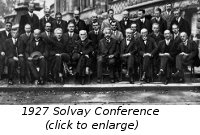 ¶ The Solvay Conferences are probably the most famous gatherings of scientific brainpower in history. In particular, the 1927 gathering included a “murderer’s row” of talented physicists.[10] Click on the image at right to view a lineup that includes many of the key players in this book.
¶ The Solvay Conferences are probably the most famous gatherings of scientific brainpower in history. In particular, the 1927 gathering included a “murderer’s row” of talented physicists.[10] Click on the image at right to view a lineup that includes many of the key players in this book.
¶ Until Einstein relocated to Princeton, North American universities or research centers are rarely mentioned in this account. Two of the three I can recall concerned the University of Wisconsin in Madison. This is the school where Joann earned her PhD in physical chemistry. She must have had (even as late as the 1990s) contact with older professors in the Chemistry Department who had worked alongside the generation of physicists there that followed some of the quantum mechanics pioneers. So her Kevin Bacon number vis-à-vis Einstein and others at Solvay ’27 may be quite low.[11]
¶ Since you have read along this far—few will have—treat your self to a somewhat-relevant favorite tune of mine from the Cranberry Lake Jug Band[12]:
—
Notes
- In part to atone for my unauthorized use of this epub, I will send a paperback copy of this book to the first person to express an interest in receiving it. Send me Feedbach. [^]
-
Good science writing aimed at a general, non-specialist audience is the work of saints. If only more Americans were interested in reading it we would be so much better off. Scientists who write popular but uncompromising accounts that I believe to be so important are sometimes derided for their efforts. Sneered at for “self-aggrandizement” and for “dumbing-down” the material (well, duh). Carl Sagan and Stephen Jay Gould are two of my favorites who were attacked in this way.
Science-literate journalists who write well are important too. Kumar seems to meet this standard. Timothy Ferris and others have made important contributions. [^]
- One variant of Bohr’s quote is “If you think you can talk about quantum theory without feeling dizzy, you haven’t understood the first thing about it.” (Source: Wikiquote). [^]
- Yes, women were systematically and almost entirely excluded from participation in professional science at this time. Marie Curie, an attendee of the 1927 Solvay Conference, was a brilliant exception. She did not, however, involve herself in the field of quantum mechanics. [^]
- One of the most important takeaways from this book is a real sense of how scientific progress is a series of mistakes, half-truths, dead ends and misunderstandings that nevertheless lead ever closer to profound truths. Somewhat emblematic of that is this passage from chapter 8: “Although it was later shown to be incorrect, his first scientific paper brought Heisenberg to the attention of Europe’s leading physicists. Bohr was one of those who sat up and took notice.” [Emphasis mine] We are not told what was incorrect, but it is interesting to know that a “failure” nevertheless led Bohr to correctly identify a new, brilliant mind. [^]
- I’m sure I have read of and then forgotten about the depths of Einstein’s despair over his failure to overturn what was in his view an incomplete if not incorrect understanding of quantum mechanics. I read Walter Isaacson’s compelling and comprehensive (700+ page) biography Einstein: His Life and Universe just a few years ago (who wants to borrow it?). And that was not the first biography I have read of the man whose brain I would most like to pick. [^]
-
Heisenberg coined the term “Copenhagen interpretation” in 1930. For a description of it, see Wikipedia.
I visited at least five parks in central Copenhagen back in the summer of 2013. I am bummed that I missed (by a perhaps a quarter of a mile) visiting the park where Heisenberg took a post-midnight manic stroll after his idea of quantum uncertainty struck. [^]
- It is no longer just a thought experiment; it has been tested and confirmed more than once. On the EPR paradox and a quite recent application of it in relation to Einstein’s Lightbox thought experiment, see this essay in the MIT Technology Review. [^]
-
Upon reading about Schrödinger’s interesting domestic arrangement, I told Joann of my “Schrödinger’s pussy” conjecture. She rolled her eyes. A peer review rejection.
By the way, after watching too much NBA basketball last season and seeing quite a bit of Atlanta guard Dennis Schröder (a native of Germany), I understand better than ever that Schrödinger’s name should be pronounced something like SHREWD-ing-grr. Unless you are German and naturally pronounce “Bach” as if you are trying to spit, I’d recommend you continue saying “Schrödinger” as if it rhymes with “toad injure.” Otherwise you will just sound like a pompous ass. [^]
- A more familiar “Murderer’s Row” of 1927 played baseball in New York as the Yankees. See Wikipedia. [^]
- Making my Bacon number no more than one greater than hers. It is possible that mine is equal to hers if I can count a brief encounter I had thanks to my position as Hamline University Science Department groupie years ago. I was honored to drive Nobel prize-winning chemist Dudley Herschbach from campus back to his downtown St. Paul hotel. We discussed Benjamin Franklin and Herschbach’s Harvard colleague Stephen Jay Gould. Dudley and I haven’t exactly kept in touch over the years, but I consider him a close personal friend. :-) [^]
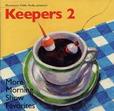 This song by the Cranberry Lake Jug Band is the last track on my Keepers 2: More Morning Show Favorites CD. It is a prized possession and a souvenir of the late, lamented Minnesota Public Radio program. The CD contains another highly-recommended track on a subject about which I know nothing, the “Impressionists Two-step” by Pop Wagner and Jack Hansen. You should definitely listen to it here on YouTube. [^]
This song by the Cranberry Lake Jug Band is the last track on my Keepers 2: More Morning Show Favorites CD. It is a prized possession and a souvenir of the late, lamented Minnesota Public Radio program. The CD contains another highly-recommended track on a subject about which I know nothing, the “Impressionists Two-step” by Pop Wagner and Jack Hansen. You should definitely listen to it here on YouTube. [^]
| DATE | TITLE |
| 12/09/2019 | Books 2019: #2 Dozen Really Matter? |
| 05/20/2019 | Why Not Both? |
| 04/23/2019 | Books 2019: #1 Take Ten |
| 04/15/2019 | Books 2018: #31 - #37 |
| see also ... | 113 Great 20th Century Novels |
| 46 Great 20th Century Crime Novels | |
| 45+ Great 20th Century SciFi/Fantasy Novels | |
| Books Read (2008-) | |
| Index of Book Posts |
